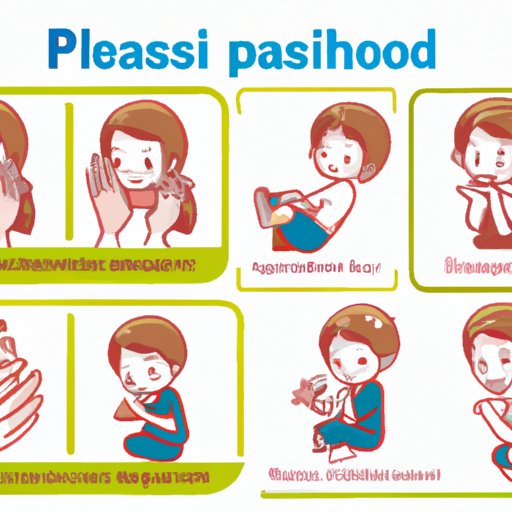
I. Introduction
Hand, foot, and mouth disease is a viral infection caused by the coxsackievirus. It is common among young children, but can also affect adults. The virus spreads easily through bodily fluids and can be challenging to manage. It’s important to know how to prevent and manage this disease to keep you and your loved ones safe.
II. Ways to Prevent Hand, Foot, and Mouth Disease Among Young Children
The virus spreads rapidly among children, especially in communal settings such as daycares and preschools. The first step to preventing the infection is through good hygiene habits such as washing hands frequently and keeping hands, feet, and mouth clean. Parents can also follow these tips to prevent the spread of the virus:
- Disinfect surfaces regularly
- Teach children to cover their mouths and noses when coughing or sneezing
- Avoid sharing food or drinks
- Keep children home when they’re sick
The risk of getting infected by the virus is highest in children under 5 years of age. Therefore, parents need to take extra precautions to keep young children safe. Reducing contact with others, avoiding crowded places, and washing hands are some measures to reduce the risk of infection.
III. Common Symptoms of Hand, Foot, and Mouth Disease
The symptoms of hand, foot, and mouth disease are similar in both children and adults. They include:
- Fever
- Sore throat
- Blisters on hands, feet, and mouth
- Loss of appetite
- Irritability
- Headache
The virus spreads through bodily fluids such as nasal and throat secretion, and feces. Direct contact with infected individuals or touching contaminated surfaces can also transmit the virus. If you suspect that you or your child has contracted the disease, it is essential to seek medical attention promptly.
IV. Caring for Someone with Hand, Foot, and Mouth Disease
Hand, foot, and mouth disease usually resolves on its own within a few days. However, if the symptoms persist or worsen, it could be an indication of a severe case or secondary infection. To care for someone infected with the virus, ensure they:
- Stay hydrated by drinking plenty of fluids
- Get lots of rest
- Take pain relievers prescribed by a physician to reduce fever and pain
- Apply medicated creams for treating blisters and sores
Complications resulting from hand, foot, and mouth disease are rare but could lead to more severe illnesses such as meningitis. Therefore, it’s essential to seek medical attention if symptoms persist or worsen after a few days.
V. Foods to Eat to Recover From Hand, Foot, and Mouth Disease
Eating a balanced diet is vital for maintaining a healthy immune system. Children infected with the virus may lose their appetite, making it challenging to eat the right foods. Parents can offer a variety of nutritious foods such as:
- Fruits rich in vitamin C
- Green leafy vegetables
- Protein-rich foods such as chicken, eggs, and yogurt
- Whole grains
Nutritional advice coupled with plenty of fluids can help in the speedy recovery of the person infected with the virus.
VI. When to Keep Your Child Home from School or Daycare Due to Hand, Foot, and Mouth Disease
Hand, foot, and mouth disease is highly contagious. Parents, guardians, and caregivers may face the question of whether their child is well enough to return to school or daycare. There is no set time frame for when a child can return to school or daycare after contracting the disease. However, here are a few tips to guide parents when deciding if their child is well enough to return to school:
- Fever-free for 24 hours
- No active diarrhea or vomiting
- No new blisters or sores that have opened or oozing fluid
- The child feels well enough to participate in usual activities and tolerate a full day in school or daycare
Additional measures to prevent the spread of the disease in public settings include disinfecting surfaces regularly, washing hands frequently, and covering mouths and noses when coughing or sneezing.
VII. Preventing Hand, Foot, and Mouth Disease in Adults
While hand, foot, and mouth disease is common in children, it can also affect adults. Adults can protect themselves from the virus by:
- Washing hands frequently, especially when interacting with children
- Avoid sharing utensils, cups, or personal items
- Disinfecting surfaces regularly
- Avoid contact with infected individuals
Although the incidence of severe complication in adults is minimal, secondary infections and meningitis could result from the virus.
VIII. Conclusion
Hand, foot, and mouth disease is a highly contagious viral infection with severe complications. It’s prevalent in young children and can also affect adults. Parents and caregivers can reduce the risk of infection by following good hygiene habits and taking precautions when their child falls ill. Seeking medical attention promptly and eating a balanced diet helps in the speedy recovery of an individual infected with the virus.
By staying informed and vigilant, we can protect ourselves and our loved ones from the hazards of hand, foot, and mouth disease.





